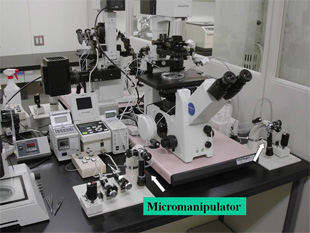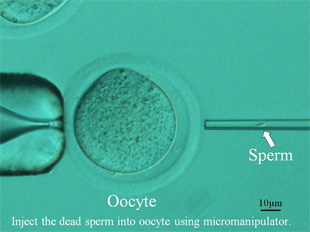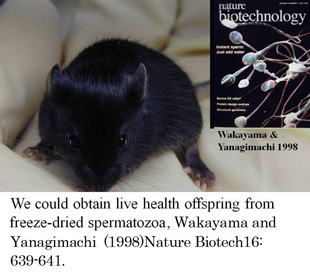This is an archive of information released in the past.
Disclaimer: It may contain broken links or outdated information. Some parts may not function in current web browsers.
*Visit https://humans-in-space.jaxa.jp/en/ for the latest information.

Experiment
- News
- Kibo Utilization Strategy
- Kibo Utilization Plan
- List of JAXA's Utilization Themes
- Experiment Facilities
- Space Environment Utilization
- Archive
Space Pup Experiment Details
Background

Figure 1 A micromanipulator and a microscope in a laboratory on the ground

Figure 2 Microinsemination with a micromanipulator

Figure 3 The first-ever production of mouse pups using freeze-dried spermatozoa (result obtained in a ground experiment)
Research on fertilization and development in space has been performed with fish and amphibians, which have been shown to be able to breed in microgravity conditions without complications. However, for research on mammalian reproduction, there has only been one study on the effect of microgravity in the late stage of pregnancy, and there are almost no studies on fertilization and early development. Mammals are sensitive to changes in the environment, and there is a high probability that they will not mate even if they are brought to space. In a rat embryology experiment performed in a Russian satellite, Cosmos 1129, rats in the flight group and also in the control group on the ground did not show reproductive behavior, and the experiment resulted in failure.
Although research has been conducted on fish and amphibian germ cells in space, an experiment with mammalian germ cells would require delicate, microscopic manipulation due to their small size, and this operation has not been realized by astronauts in microgravity conditions.
Studies on mammalian fertilization in space are complicated by several factors, including the need to carry out complicated operations under a microscope, as described above; the limited number of opportunities for experimentation due to the limited chances of transport to and recovery from space; and the short life span (only a few days) of mammalian germ cells at room temperature. However, Professor Wakayama’s group has performed microinsemination with a micromanipulator for years and has addressed various challenges to conduct research with mice in space (Figures 1 and 2). In 1998, the group was the first to succeed in producing mouse pups using freeze-dried spermatozoa (Figure 3). In the same year, the group also succeeded in the first-ever production of cloned mice from somatic cells, using a similar technique. Furthermore, in 2008, the group successfully created cloned mice from bodies frozen for 16 years. The combination of micromanipulator techniques and technology for freeze-drying spermatozoa the group has developed so far will enable us to make the best of the chances for transport to and recovery from space and to resolve the causes of failure described above.
Objective
Although the effect of microgravity conditions on mammals in the early development stage is a highly interesting aspect, no one has succeeded in performing experiments to examine it. Experiments in space are indispensable for verifying whether early development will occur or not.
However, all technical constraints for launch must be overcome to perform space experiments. By using technology to produce offspring from freeze-dried and preserved spermatozoa, this experiment aims to reveal the effects of cosmic radiation on spermatozoa by producing offspring on the ground from spermatozoa stored in space for a certain period of time. This experiment is expected to produce the first mammalian offspring from space-travelled spermatozoa and to show the potential of space as an ultimate depository for conservation of genetic resources. Subsequently, we will improve and develop the experimental system on the basis of these results with the final aim of producing offspring in space.
Outline of the Experiment
Mouse spermatozoa that have been freeze-dried on the ground will be sent to the ISS and preserved in the Minus Eighty-Degree Laboratory Freezer for ISS (MELFI). The samples will be returned to Earth singly, in three batches: five months, one year, and two years after launching (Figure 4). The returned spermatozoa will be used for microinsemination (injecting a sperm cell directly into an egg cell under a microscope). Next, the space sperm will be examined for fertility, effects of radiation, DNA damage (repair) rate, normalcy of early development, and most importantly, the birth rate. These experiments will reveal how storage in space affects the integrity of spermatozoa.

Figure 4 Ampoule used for the space experiment
This is the Point!
Because projects to conserve the genetic resources of various species require a continuous supply of electric power and liquid nitrogen, they can fail if they suffer from accidents such as earthquakes or other natural disasters. The results of the present research will be applied to conservation of germ cells, which aids in breeding of high-quality livestock, an important theme in thremmatology and animal husbandry, and can aid in the conservation of species of profitable experimental animals.
In addition, if this research demonstrates that germ cells can be preserved in space, the possibility of using space and the Moon as ultimate depositories for genetic resource conservation will be expanded.
| Copyright 2007 Japan Aerospace Exploration Agency | Site Policy |